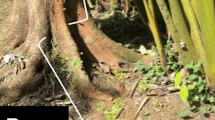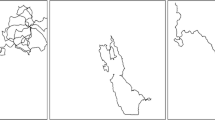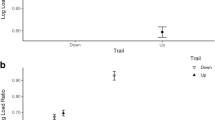Abstract
During foraging, leaf-cutting ant workers of different size classes perform various tasks along foraging trails. Commonly, small workers called hitchhikers climb on leaf fragments imposing an extra transport cost, so their presence is thought to reduce the individual foraging performance. There are four main hypotheses which may explain the occurrence of hitchhikers and a different behavioral act related to their role can be predicted for each. Hitchhiker behavior was observed considering these hypotheses and the effect of the hitchhikers on the walking speed and transport rate of foragers was evaluated. The behavioral registers were obtained from 1371 hitchhikers on foraging trails of Acromyrmex subterraneus subterraneus nests in the field. To verify the influence of hitchhikers on walking speed and transport rate, 239 foragers with hitchhikers and 250 foragers transporting only leaf fragments were analyzed. The walking speed, burden and transport rate of each forager were calculated. Data indicated not only that hitchhikers are vigilant but that they remain motionless on the leaf fragment probably in order to reduce the impact of their presence for the loaded forager. The impact of their presence is verified through walking speed reduction but as they ride preferentially on larger workers who transport larger leaf fragments, there are no losses in the individual transport rate. The transporter selection made by the hitchhiker ensures at the same time enhanced protection against phorid parasitoids and the maintenance of the leaf transport rate.



Similar content being viewed by others
References
Altmann J (1974) Observational study of behavior: sampling methods. Behaviour 227-267
Belt T (1874) The naturalist in Nicaragua. JM Dent and Sons, London, UK
Bragança MAL, Tonhasca JRA, Della Lucia TMC (1998) Reduction in the foraging activity of the leaf-cutting ant Atta sexdens caused by the phorid Neodohrniphora sp. Entomol Exp Appl 89:305–311
Burd M (2000) Body size effects on locomotion and load carriage in the highly polymorphic leaf-cutting ants Atta colombica and Atta cephalotes. Behav Ecol 11:125–131. doi:10.1093/beheco/11.2.125
Camargo RS, Forti LC, Matos CAO, Lopes JFS, Andrade APP, Ramos VM (2003) Post-selection and return of foraged material by Acromyrmex subterraneus brunneus (Hymenoptera: Formicidae). Sociobiology 42:93–102
Constant N, Santorelli LA, Lopes JFS, Hughes WO (2012) The effects of genotype, caste, and age on foraging performance in leaf-cutting ants. Behav Ecol. doi:10.1093/beheco/ars116
Eibl-Eibesfeldt I, Eibl-Eibesfeldt E (1967) Das Parasitenabwehrender Minima-Arbeiterinnen der Blattschneider-Ameise (Atta cephalotes). Z Tierpsychol 24:278–281
Elizalde L, Folgarait PJ (2011) Biological attributes of Argentinian phorid parasitoids (Insecta: Diptera: Phoridae) of leaf-cutting ants, Acromyrmex and Atta. J Nat Hist 45:2701–2723
Elizalde L, Folgarait PJ (2012) Behavioral strategies of phorid parasitoids and responses of their hosts, the leaf-cutting ants. J Insect Sci 12:1–26
Feener DHJ, Brown BV (1993) Oviposition behavior of an ant parasitizing fly, Neodohrniphora curvinervis (Diptera: Phoridae), and defense behavior by its leaf-cutting ant host Atta cephalotes (Hymenoptera: Formicidae). J Insect Behav 6:675–688
Feener DHJ, Moss KAG (1990) Defense against parasites by hitchhikers in leaf-cutting ants: a quantitative assessment. Behav Ecol Sociobiol 26:17–29
Griffiths HM, Hughes WO (2010) Hitchhiking and the removal of microbial contaminants by leaf-cutting ant Atta colombica. Ecol Entomol 35:529–537
Hurlbert AH, Iv FB, Powell S (2008) Shaking a leg and hot to trot: the effects of body size and temperature on running speed in ants. Ecol Entomol 33:144–154
Kitayama K, Gramacho MG (2002) Foraging activities of an Atta sexdens (Hymenoptera: Formicidae: Attini) colony. Sociobiology 39:15–23
Kost C, Game de Oliveira E, Knoch TA, Wirth R (2005) Spatio-temporal permanence of plasticity of foraging trails in young and mature leaf-cutting ant colonies (Atta spp.). J Trop Ecol 21:677–688
Linksvayer TA, McCall AC, Jensen RM, Marshall CM, Miner JW, McKone MJ (2002) The function of hitchhiking behavior in the leaf-cutting ant Atta cephalotes. Biotropica 34:93–100
Lutz FE (1929) Observations on leaf cutting ants. Am Mus Novit 388:1–21
Moll K, Roces F, Federle B (2010) Foraging grass-cutting ants (Atta vollenweideri) maintain stability by balancing their loads with controlled head movements. J Comp Physiol 196:471–480
Norton V, Stevens-Wood B, Harris WE (2013) Flexibility of individual load-mass selection in relation to foraging trail gradient in the leaf-cutter ant Acromyrmex octospinosus. J Insect Behav 27:370–384
Orr MR (1992) Parasitic flies (Diptera: Phoridae) influence foraging rhythms and caste division of labor in the leaf-cutter ant, Atta cephalotes (Hymenoptera: Formicidae). Behav Ecol Sociobiol 30:395–402
Pyke HG (1984) Optimal foraging theory: a critical review. Annu Rev Ecol Syst 15:523–575
R Development Core Team (2009) R: A language and environment for statistical computing. R Foundation for Statistical Computing, Vienna, Austria URL http://wwwr-projectorg/ Acesssed in 12 November 2012
Roces F (1990) Leaf-cutting ants cut fragment sizes in relation to the distance from the nest. Anim Behav 40.6:1181–1183
Roces F (2002) Individual complexity and self-organization in foraging by leaf-cutting ants. Biol Bull 202:306–313
Roces F, Hölldobler B (1994) Leaf density and a trade-off between load-size selection and recruitment behavior in the ant Atta cephalotes. Oecologia 97:1–8
Roces F, Hölldobler B (f1995) Vibrational communication between hitchhikers and foragers in leaf-cutting ants (Atta cephalotes). Behav Ecol Sociobiol 37:297–302
Rudolph SG, Loudon C (1986) Load size selection by foraging leafcutter ants (Atta cephalotes). Ecol Entomol 11:401–410
Stradling DJ (1978) The influence of size on foraging in the ant, Atta cephalotes, and the effect of some plant defence mechanisms. J Anim Ecol 47:173–188
Vieira-Neto EHM, Mundim FM, Vasconcelos HL (2006) Hitchhiking behaviour in leaf-cutter ants: An experimental evaluation of three hypotheses. Insect Soc 53:326–332
Traniello JFA (1989) Foraging strategies in ants. Annu Rev Entomol 34:191–210
Wetterer JK (1991) Foraging ecology of the leaf-cutting ant Acromyrmex octospinosus in a Costa Rican rain forest. Psyché 98:361–368
Wetterer JK (1999) The ecology and evolution of worker size-distribution in leaf-cutting ants (Hymenoptera: Formicidae). Sociobiology 34:119–144
Wilson EO (1980) Caste and division of labor in leaf-cutter ants (Hymenoptera, Formicidae, Atta). 2. The ergonomic optimization of leaf cutting. Behav Ecol Sociobiol 7:157–165
Yackulic CB, Lewis OT (2007) Temporal variation I foraging activity and efficiency and role of hitchhiking behaviour in leaf-cutting ant, Atta cephalotes. Entomol Exp Appl 125:125–134
Zollikofer CPE (1994a) Stepping patterns in ants. 2. Influence of body morphology. J Exp Biol 192:107–118
Zollikofer CPE (1994b) Stepping patterns in ants. 3. Influence of load. J Exp Biol 192:119–127
Acknowledgments
From I.N. Hastenreiter, T.A.Sales and L.F.Ribeiro thanks go to Coordenação de Aperfeiçoamento de Pessoal de Nível Superior (CAPES) and Pró-Reitoria de Pesquisa (Propesq) – UFJF for a grant. From J.F.S. Lopes thanks go to Conselho Nacional de Desenvolvimento Científico e Tecnológico (CNPq) for grant and financial support (307335/2009-7 and 569962/2008-0). The authors thank Dr. Kleber Del-Claro and two anonymous reviewers whose comments improved the manuscript, Dr. Vincent Fourcassié and Dra. Jane Azevedo da Silva for statistical analysis advice.
Author information
Authors and Affiliations
Corresponding author
Rights and permissions
About this article
Cite this article
Hastenreiter, I.N., de Sales, T.A., Ribeiro, L.F. et al. A Convenient Trip: an Analysis of the Impact of Hitchhiker Ants on Forager Transport Rates. J Insect Behav 29, 37–47 (2016). https://doi.org/10.1007/s10905-015-9540-2
Revised:
Accepted:
Published:
Issue Date:
DOI: https://doi.org/10.1007/s10905-015-9540-2




